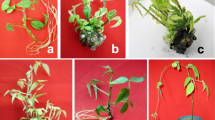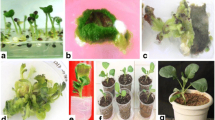Abstract
Induction of shoots is possible from cotyledonary node of Vigna radiata seedlings by culturing them on a low concentration of thidiazuron (TDZ 1.0 μM). Interestingly, flooding the seedlings with the same concentration of TDZ considerably enhanced this effect and also led to the induction of shoots from the epicotyl – an unexpected and significant finding. Even plain mineral medium evoked this response on flooding. But seedlings raised on TDZ and flooding with mineral medium was not so effective. Instead seedlings raised on TDZ (1.0 μM) medium as well as flooding with it had synergistic effect. In a comparative study TDZ (1.0 μM) was found to be more effective than BAP (10 μM). Marked repression of root formation and expansion of shoot–apex were noted in seedlings raised on TDZ or BAP, particularly in cultures that were flooded.
Similar content being viewed by others
Abbreviations
- BAP:
-
6-benzylamino purine
- TDZ:
-
thidiazuron (N-phenyl-N′-1,2,3 thidiazol-5-yl urea)
- IBA:
-
indole butyric acid
References
Barwarle UB, Kerns HR, Widholm JM (1986) Plant regeneration from callus cultures of several soybean genotypes via embryogenesis and organogenesisPlanta 167:473–481
Brand U, Fletcher JC, Hobo M, Meyerowitz EM, Simon R (2000) Dependence of stem cell fate in Arabidopsis on a feed back loop regulated by CLV 3 activityScience 289:617–619
Cheng TY, Saka H, Voqui-Dinh TM (1980) Plant regeneration from cotyledonary node segments in culturePlant Sci. Lett. 19:91–99
Chu CC, Wang CC, Sun CS, Hsu C, Yin KC, Chu CY, Bi YB (1975) Establishment of an efficient medium for anther culture of rice through comparative experiment on the nitrogen sourcesSci. Sinica 18: 659–668
Cruz de MH, Van Le B, Zuily-Fodil Y, Pham Thi AT, Thanh Van KT (2000) Efficient whole plant regeneration of common bean (Phaseolus vulgaris L.) using thin-cell-layer culture and silver nitratePlant Sci. 159:223–232
Das DK, Prakash NS, Bhalla-Sarin (1998) An efficient regeneration system of black gram (Vigna mungo L.) through organogenesis Plant Sci. 134:199–206
Etienne H, Berthouly M (2002) Temporary immersion systems in plant micropropagationPlant Cell Tiss. Org. Cult. 69: 215–231
Gairi A, Rashid A (2004) Direct differentiation of somatic embryos on different regions of intact seedlings of Azadirachta in response to thidiazuron J. Plant Physiol. 161:1073–1077
Hammat N, Davey MR (1987) Somatic embryogenesis and plant regeneration from cultured zygotic embryos of soybean (Glycine max)J. Plant Physiol. 128:219–226
Hammat N, Ghosh TK & Davey MR (1986) Regeneration in legumes. In: Vasil IK (ed) Cell Culture and Somatic Cell Genetics of Plants, Vol. 3 (pp. 66–95). Academic Press, New York
Imaseki H (1999) Control of ethylene synthesis and metabolism In: Hooykaas PJJ et al. (eds) Biochemistry and Molecular Biology of plant hormones (pp. 209–245). Elsevier
Kadota M, Numi Y (2003) Effect of cytokinin types and their concentration on shoot proliferation and hyper hydricity in in vitro pear cultivar shootsPlant Cell Tiss. Org. Cult. 72: 261–265
Lippman B, Lippman G (1984) Induction of somatic embryos in cotyledonary tissue of soybean Glycine maxPlant Cell Rep. 3:215–218
Malik KA, Saxena PK (1992) Regeneration in Phaseolus vulgaris L. high frequency induction of direct shoot formation in intact seedlings by N6-benzylaminopurine and thidiazuronPlanta 186: 731–740
Malik KA, Ali-Khan ST, Saxena PK (1993) High frequency organogenesis from direct seed culture of Lathyrus Ann. Bot. 72:629–637
Mallick MA, Rashid A (1989) Induction of multiple-shoots from cotyledonary node of grain legumes, pea and lentilBiol. Plant. 31:230–232
Mathews H (1987) Morphogenic response from in vitro cultured seedling explants of mung bean (Vigna radiata L. Wilczek)Plant Cell Tiss. Org. Cult. 11:233–240
Mundhara R, Rashid A (2001) Regeneration of shoots–buds on hypocotyls of Linum seedlings :A stress related response Plant Sci. 161:19–25
Parrot WA, Dryden G, Vogt S, Hildebrandt DF, Collins GB, Willams EG (1988) Optimisation of somatic embryogenesis and embryo germination in soybeanIn Vitro Cell Dev. Biol. Plant 24: 87–820
Sandal I, Bhattacharya A, Ahuja PS (2001) An efficient liquid culture system for tea proliferationPlant Cell Tiss. Org. Cult. 65: 75–80
Sen J, Guha-Mukherjee S (1998) In vitro induction of multiple shoots and plant regeneration in Vigna In Vitro Cell Dev. Biol. Plant 34:276–280
Tivareker S, Eapen S (2001) High frequency plant regeneration from immature cotyledons of mung beanPlant Cell Tiss. Org. Cult. 66:227–230
Yip WK, Yang SF(1986) Effect of thidiazuron, a cytokinin–active urea derivative, in cytokinin-dependent ethylene production systemPlant Physiol. 80:515–519
Werner T, Motyka V, Strnad M, Schmulling MT (2001) Regulation of plant growth by cytokininProc. Natl. Acad. Sci. USA 98:10487–10492
Werner T, Motyka V, Laucou V, Smets R, Onckelen HY, Schmulling T (2003) Cytokinin-deficient transgenic Arabidopsis plants show multiple developmental alterations indicating opposite functions of cytokinin in the regulation of shoot and root meristem activity Plant Cell 15: 2532–2550
Wright MS, Koehler MA, Hinchee MA, Carnes MG (1986) Plant regeneration by organogenesis in Glycine max Plant Cell Rep. 5: 150–154
Acknowledgement
We thank Professor S.C. Maheshwari for a critical reading of manuscript. RM is also grateful to CSIR for award of SRF.
Author information
Authors and Affiliations
Corresponding author
Rights and permissions
About this article
Cite this article
Mundhara, R., Rashid, A. Recalcitrant Grain Legume Vigna radiata, Mung Bean, Made to Regenerate on Change of Hormonal and Cultural Conditions . Plant Cell Tiss Organ Cult 85, 265–270 (2006). https://doi.org/10.1007/s11240-005-9061-3
Received:
Accepted:
Published:
Issue Date:
DOI: https://doi.org/10.1007/s11240-005-9061-3




